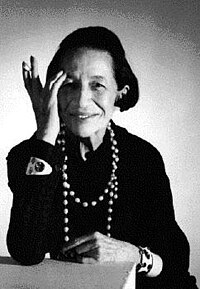fui esmigalhado, ontem, por este doc que passou no GNT!
certamente, os minutos mais impactantes que testemunhei no últimos tempos.
e olha que minha relação com o mundinho fashion é zereta… zereta total!
portanto, esqueça o peso deste trailer em roupitchas, celebridades & afins.
o documentário é uma Aula de comunicação, história, fotografia, transgressão, inteligência, educação, música… FUEDA!
imperdível!
DIANA, DIANA…
Diana Vreeland
| Diana Vreeland | |
|---|---|
 Diana Vreeland by Horst P. Horst. |
|
| Born | Diana Dalziel September 29, 1903 Paris, France |
| Died | August 22, 1989 (aged 85) Manhattan, New York United States |
| Cause of death | Heart attack |
| Occupation | Magazine editor, fashion journalist |
| Title | Editor-in-chief of Vogue |
| Spouse(s) | Thomas Reed Vreeland (m. 1924–w. 1966) |
| Children |
|
| Website | |
| www.dianavreeland.com | |
Diana Vreeland (September 29, 1903, Paris, – August 22, 1989, New York City) was a noted columnist and editor in the field offashion. She worked for the fashion magazines Harper’s Bazaar and Vogue and the Costume Institute of the Metropolitan Museum of Art. She was named to the International Best Dressed List Hall of Fame in 1965.[1]
Early life
She was born as Diana Dalziel in Paris, France, at 5 Avenue Bois de Boulogne (Avenue Foch since World War I). Vreeland was the eldest daughter of American socialite mother Emily Key Hoffman (1876-1928) and British father Frederick Young Dalziel (1868-1960). Hoffman was a descendant of George Washington‘s brother as well as a cousin of Francis Scott Key. She also was a distant cousin of writer and socialite Pauline de Rothschild (née Potter; 1908-1976). Vreeland had one sister, Alexandra (1907-1999), who later married Sir Alexander Davenport Kinloch, 12th Baronet (1902-1982).
Vreeland’s family emigrated to the United States at the outbreak of World War I, and moved to 15 East 77th Street in New York, where they became prominent figures in society. Vreeland was sent to dancing school and was a pupil of Michel Fokine, the onlyImperial Ballet master ever to leave Russia, and later of Louis Harvy Chalif. Vreeland performed in Anna Pavlova‘s Gavotte atCarnegie Hall. In January of 1922, Vreeland was featured in her future employer, Vogue, in a roundup of socialites and their cars. The story read, ““Such motors as these accelerate the social whirl. Miss Diana Dalziel, one of the most attractive debutantes of the winter, is shown entering her Cadillac.” [2]
On March 1, 1924, Diana Dalziel married Thomas Reed Vreeland (1899–1966), a banker, at St. Thomas’ Church in New York, with whom she would have two sons: Tim (Thomas Reed Vreeland, Jr.) born 1925, who became an architect as well as a professor of architecture at UCLA, and Frecky (Frederick Dalziel Vreeland) b. 1927 (later U.S. ambassador to Morocco).[3] A week before her wedding, the New York Times reported that her mother had been named co‑respondent in the divorce proceedings of Sir Charles Ross and his second wife, Patricia. The ensuing society scandal estranged Vreeland and her mother, who died in September 1928 in Nantucket, Massachusetts.[citation needed]
After their honeymoon, the Vreelands moved to Albany, New York, and raised their two sons, staying there until 1929. They then moved to 17 Hanover Terrace, Regent’s Park, London, previously the home of Wilkie Collins and Edmund Gosse. During her time in London, she danced with the Tiller Girls and met Cecil Beaton, who became a lifelong friend. Like Syrie Maugham and Elsie de Wolfe, other society women who ran their own boutiques, Diana operated a lingerie business near Berkeley Square. Her clients included Wallis Simpson and Mona Williams. She often visited Paris, where she would buy her clothes, mostly from Chanel, whom she had met in 1926. She was one of fifteen American women presented to King George V and Queen Mary at Buckingham Palace on May 18, 1933.[citation needed] In 1935 her husband’s job brought them back to New York, where they lived for the remainder of their lives.
“Before I went to work for Harper’s Bazaar in 1936, I had been leading a wonderful life in Europe. That meant traveling, seeing beautiful places, having marvelous summers, studying and reading a great deal of the time.”[4] These travels are the subject of a documentary called The Eye has to Travel, a film that pays tribute to the life of Diana Vreeland, which debuted in September 2012 at the Angelika Theater in New York City.
Career
Harper’s Bazaar 1936–1962
Her publishing career began in 1936 as columnist for Harper’s Bazaar. In 1936 the Vreelands moved from London to New York City. They found New York City to be extremely expensive. Carmel Snow, the editor of Harper’s Bazaar, was impressed with Vreeland’s clothing style and asked her to work at the magazine.[5] From 1936 until her resignation, Diana Vreeland ran a column for Harper’s Bazaar called “Why Don’t You?”. One example is a suggestion she made in the column, “Why don’t you…Turn your child into an Infanta for a fancy-dress party?”[6] According to Vreeland, “The one that seemed to cause the most attention was […] “[Why Don’t You] [w]ash your blond child’s hair in dead champagne, as they do in France.” Vreeland says that S. J. Perelman wrote a parody of it for The New Yorker magazine that outraged her then-editor Carmel Snow.[7]
Diana Vreeland “discovered” actress Lauren Bacall in the 1940s. A Harper’s Bazaar cover from the early 1940s shows Lauren Bacall posing near a Red Cross office. Based on Vreeland’s decision, “[t]here is an extraordinary photograph in which Bacall is leaning against the outside door of a Red Cross blood donor room. She wears a chic suit, gloves, a cloche hat with long waves of hair falling from it”.[8] Vreeland was noted for taking fashion seriously. She commented in 1946 that “[T]he bikini is the most important thing since the atom bomb“.[9] Vreeland disliked the common approach to dressing that she saw in the United States in the 1940s. She detested “strappy high-heel shoes” and the “crêpe de chine dresses” that women wore even in the heat of the summer in the country.[10]
Until her resignation at Harper’s Bazaar, she worked closely with Louise Dahl-Wolfe,[11] Richard Avedon, Nancy White,[12] and Alexey Brodovitch. Diana Vreeland becameFashion Editor for the magazine. Richard Avedon said when he first met Diana Vreeland and worked for Harper’s Bazaar, “Vreeland returned to her desk, looked up at me for the first time and said, ‘Aberdeen, Aberdeen, doesn’t it make you want to cry?’ Well, it did. I went back to Carmel Snow and said, ‘I can’t work with that woman. She calls me Aberdeen.’ And Carmel Snow said, ‘You’re going to work with her.’ And I did, to my enormous benefit, for almost 40 years.”[13] Avedon said at the time of her death that “she was and remains the only genius fashion editor”.[14]
In 1955 the Vreelands moved to a new apartment which was decorated exclusively in red. Diana Vreeland had Billy Baldwin decorate her apartment.[15] She said, “I want this place to look like a garden, but a garden in hell”.[13] Regular attendees at the parties the Vreelands threw were socialite C. Z. Guest, composer Cole Porter, and British photographer Cecil Beaton[13] Paramount‘s 1957 movie musical Funny Face featured a character—Maggie Prescott as portrayed by Kay Thompson—based on Vreeland.[16]
In 1960 John F. Kennedy became president and Diana Vreeland advised the First Lady Jacqueline Kennedy in matters of style. “Vreeland advised Jackie throughout the campaign and helped connect her with fashion designer Oleg Cassini, who became chief designer to the first lady”.[17] “I can remember Jackie Kennedy, right after she moved into the White House…It wasn’t even like a country club, if you see what I mean-plain.” Vreeland occasionally gave Mrs. Kennedy advice about clothing during her husband’s administration, and small advice about what to wear on Inauguration Day in 1961.[18]
In spite of being extremely successful, Diana Vreeland made a small amount of money from the Hearst Corporation, which owned Harper’s Bazaar. Vreeland says that she was paid $18,000 a year from 1936 with a $1,000 raise, finally, in 1959. She speculated that newspaper magnate William Randolph Hearst‘s castle in San Simeon, California, “must have been where the Hearst money went”.[19]
Vogue 1963–1971 and the Metropolitan Museum of Art
According to some sources, hurt that she was passed over for promotion at Harper’s Bazaar in 1957, she joined Vogue in 1962. She was editor-in-chief from 1963 until 1971. Vreeland enjoyed the sixties enormously because she felt that uniqueness was being celebrated. “If you had a bump on your nose, it made no difference so long as you had a marvelous body and good carriage.”[20] During her tenure at the magazine, she discovered the sixties “youthquake” star Edie Sedgwick. In 1984 Vreeland explained how she saw fashion magazines. “What these magazines gave was a point of view. Most people haven’t got a point of view; they need to have it given to them-and what’s more, they expect it from you. […][I]t must have been 1966 or ’67. I published this big fashion slogan: This is the year of do it yourself. […][E]very store in the country telephoned to say, ‘Look, you have to tell people. No one wants to do it themselves-they want direction and to follow a leader!'”[21]
After she was fired from Vogue, she became consultant to the Costume Institute of the Metropolitan Museum of Art in New York in 1971. By 1984, according to Vreeland’s account, she had organized twelve exhibitions.[22] Artist Greer Lankton created a life-size portrait doll of Vreeland that is on display at the museum.
Later years
In 1984 Vreeland wrote her autobiography, D.V. In 1989 she died of a heart attack at age 86 at Lenox Hill Hospital, on Manhattan’s Upper East Side in New York City.
